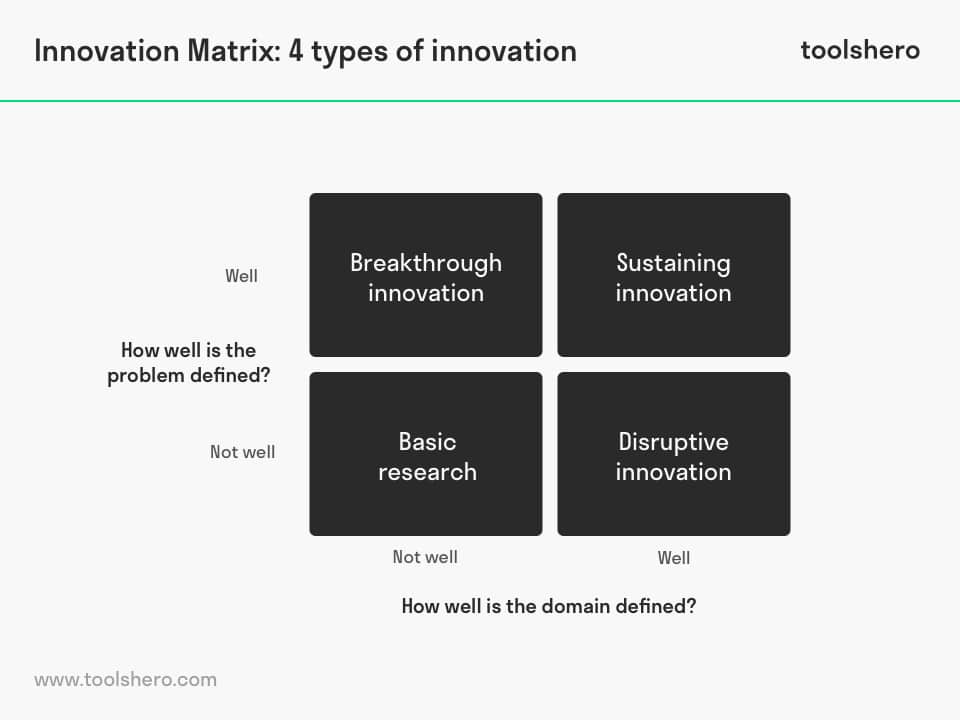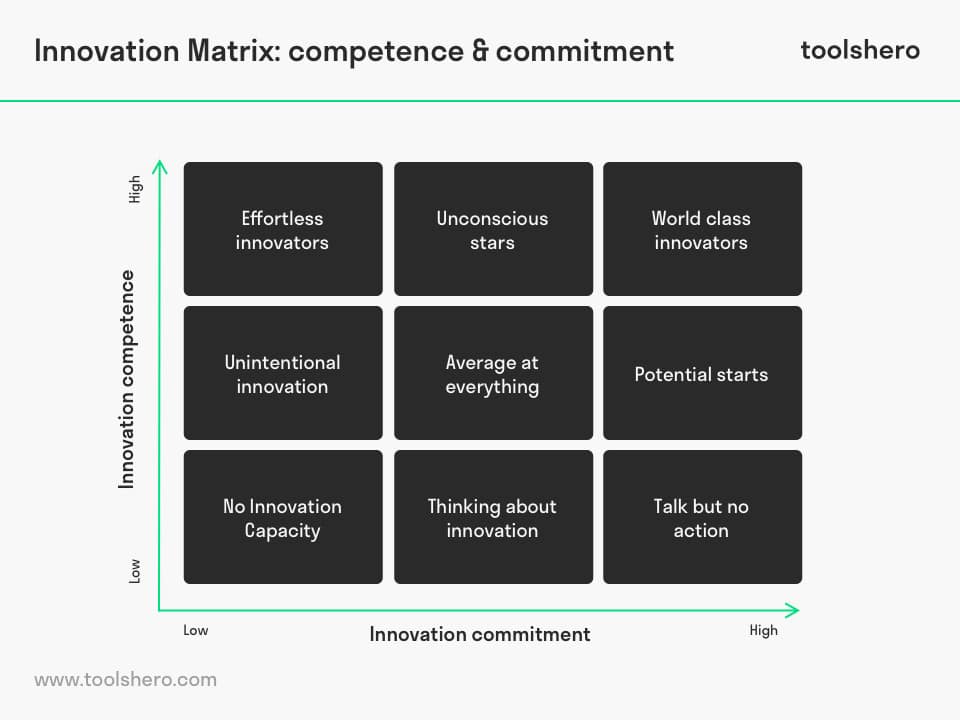Innovation Matrix

Innovation Matrix: this article provides a practical explanation of the Innovation Matrix. After reading, you’ll understand the basics of this powerful innovation tool.
What is the Innovation Matrix?
The Innovation Matrix is a visualisation that incorporates the various aspects of innovation. There are various innovation matrices. This article deals with the basic Innovation Matrix including the four different types of innovation—and the competence-based Innovation Matrix.
Innovation is often misunderstood, which is partly because every innovation is viewed from the same perspective. Innovation, however, is a diverse activity, and occurs in laboratories, universities, and research centres. But even during a coffee or a beer after work, people are constantly thinking of ways to improve something or solve a problem. Different types of problems and issues are approached in different ways.
Galileo, Newton, Nikola Tesla, and Steve Jobs are among the most successful innovators and inventors ever.
Innovation Matrix: 4 Types of Innovation
Albert Einstein once said: ‘If I had 20 days to solve a problem, I would take 19 days to define it.’ Indeed, defining the problem is the most important step in solving it. The ability to define a problem is an important aspect in choosing the right strategy to solve it. Another aspect in choosing the right innovation strategy is the ability to define the domain and skills necessary to solve the problem.
Innovation Matrix : Breakthrough Innovation
This innovation is sometimes also called radical innovation, or revolutionary innovation. The matrix shows that the problem is generally well formulated, but that the road towards it, the skills, and domain are still somewhat unclear. Thomas Kuhn referred to this innovation as revolutionary because it creates a paradigm shift. For example, this happened when the structure of DNA was discovered, or when the chip was invented.
Innovation Matrix : Disruptive Innovation
It was Professor Clayton Christensen who introduced the concept of disruptive innovation. He realised that many organisations shape their innovation in the ‘best possible’ way, by listening to customers and investing in research & development, even though in some situations these best practices could be deadly. He discovered that when the basis of competition changes (such as competitors or technological developments), organisations become increasingly better at innovating products that people want less and less.
Innovation Matrix : Basic Research
At the bottom left of the Innovation Matrix is basic research. Groundbreaking innovations almost never arise out of the blue. More often than not, a major discovery precedes them. If Albert Einstein hadn’t shared his vision and discoveries about black holes with the world, the astronomers with the Event Horizon Telescope might not have succeeded in photographing the phenomenon.
Basic research is conducted by large companies that invest in R&D, universities, government institutions, non-profit research centres, and individuals.
Innovation Matrix : Sustaining Innovation
Sustaining innovation also refers to incremental innovation. Most innovation is conducted because something needs to perform better than it is able to do now. The goal is improve and expand existing possibilities. As can be seen in the innovation matrix, problems are well defined and the road ahead is also clear.
Innovation Matrix: Competence and Dedication
Innovation takes places in many sectors, in many ways, and at different moments in time. An overview of which innovators there are and how much capacity they have can be plotted in the following innovation matrix.
The Innovation Matrix has two dimensions. The vertical line shows the degree of innovation competency. This is an organisation’s ability to come up with and implement new ideas. The horizontal line shows an organisation’s degree of dedication towards innovation. It is about how important innovation is for the organisation, how much effort and resources it invests in innovation, and how innovation is part of a company’s core competencies.
No Innovation Capacity
This category of organisations doesn’t really innovate. This doesn’t have to be a bad thing, though. Some organisations don’t innovate, but do create added value. Sometimes these companies are successful because of their strong position in the market, whereas others perform at an average level or have a difficult time.
Thinking About Innovation
The companies in this category are not yet major innovators, but are slowly starting to talk about innovation and beginning to recognise its importance. This initiative often comes from higher management, for example from the CEO’s vision. Although companies in this category pay more attention to innovation compared to the first category, these companies certainly do not excel at innovation yet.
Talk But No Action
The third category of the innovation matrix includes companies that pay close attention to innovation, but that do not actually realise it yet. For example, official innovation programmes have been introduced and meetings are organised, but there is no actual innovation.
Unintentional Innovation
The innovators in this category already innovate under a certain name, but do not actually believe they are good innovators. Although these companies have the ability to innovate, they don’t have the structure and resources to support it.
Average at Everything
These organisations have managed to put in place a good innovation structure, and are generally also getting better at innovating. This group certainly has the potential to grow into excellent innovators.
Potential Stars
These companies can innovate well, and therefore allocate more and more resources to innovation as a business activity. They are organisations that are dedicated to innovation, and which have set innovation as the company’s focal point. This group is able to generate new ideas well, and has the potential to grow into absolute stars.
Effortless Innovators
Effortless innovators are the group of companies that have been engaged in innovation for a long time. Their structure is optimally laid out and they have sufficient resources at their disposal. This group is very good at innovating. Although not too much money is spent on innovation, there is an attempt to consciously innovate.
Unconscious Stars
These companies resemble the Unintentional Innovation group, but are better at implementing new ideas. Although they are often incremental innovations, these companies can generate a large amount of ideas and actually implement them.
World Class Innovators
This group includes the very best in their field: Google, Apple, Proctor & Gamble, etc. These companies are fully geared towards innovation, and they are often leaders in their field.
Now it’s your turn
What do you think? Are you familiar with the explanation about the innovation matrix? What do you believe is the importance of innovation for companies? What types of innovation do you recognise in well-known and major organisations in your direct environment? How important do you believe a vision based on innovation is? Do you have any tips or additional comments?
Share your experience and knowledge in the comments box below.
More information
- Busarovs, A. (2013). Open innovation: current trends and future perspectives. Humanities and Social Sciences, 21(2), 103-119.
- Huizingh, E. K. (2011). Open innovation: State of the art and future perspectives. Technovation, 31(1), 2-9.
- Kyffin, S., & Gardien, P. (2009). Navigating the innovation matrix: An approach to design-led innovation. International Journal of Design, 3(1).
How to cite this article:
Janse, B. (2019). Innovation Matrix. Retrieved [insert date] from toolshero: https://www.toolshero.com/innovation/innovation-matrix/
Original publication date: 28/10/2019 | Last update: 15/02/2022
Add a link to this page on your website:
<a href=”https://www.toolshero.com/innovation/innovation-matrix/”>toolshero: Innovation Matrix</a>








